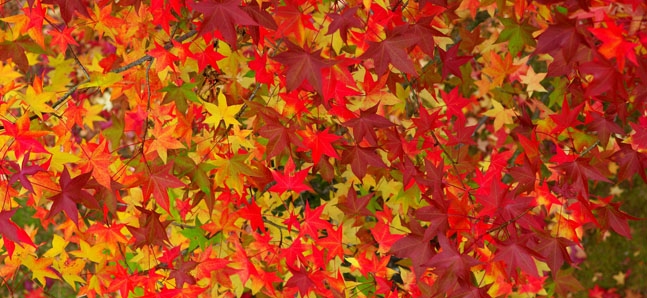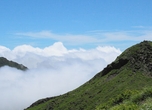
Posted: Fri Nov 05 2010
The wave of changing autumn leaves begins in the north and sweeps south through Japan, changing colours from green to yellow to red and erasing all memory of the sweltering heat of only a few weeks ago – a heat that, incidentally, should make for some particularly vivid colour changes this fall. Below, we’ve put together a list of five easy to follow train routes that offer some spectacular autumn views. Note the dates inside the brackets after each heading, which indicate the optimal to go.
Ome Line (from early November)
An Ometokkai (a special rapid train bound for Ome, on the Chuo Line) will take you from Tokyo to Ome, a town through which the Tama River (which boasts a wealth of beautiful upstream autumn scenery) flows, in about one-and-a-half hours. After arriving at Ome, catch a train heading to Okutama, and soon after the line begins to trace the shape of the neighbouring hills, you’ll be presented with a view of – as the second Japanese character in the name Ome indicates – plum trees.
After passing through a short tunnel, the line suddenly draws alongside Tama River before calling at Ikusabata Station – after which you’ll begin to see the autumn trees on both side of the valley. The area from here to Mitake Station, a little less than 10 minutes away, is known as the Mitake Keikoku (keikoku meaning ravine or valley), through which, in addition to the two narrow train tracks, there’s also a walkway to stretch your legs and enjoy the colours of the autumn leaves along. In addition to beautiful autumn scenery, another attraction of the Mitake Keikoku is Tokyo’s largest sake (Japanese rice wine) brewery, Ozawa Shuzo, which offers guided tours of the facility and sake tasting.
Travelling further down the line, through the Hato-no-Su-Keikoku (Hato-no-Su Valley), brings you to Okutama Station, the line’s terminus and the end of this particular autumn leaf viewing train ride – which will have run for approximately 20km and taken somewhere close to 35 minutes. However, although this is end of the line, there’s always the journey back to be enjoyed, which, if it takes your fancy, could include stopping off along the way for a closer look around and perhaps even a dip in one of the many local hot springs.
Chichibu Main Line (from early November)
The Chichibu Main Line runs from east to west, across northern Saitama; however, when it comes to autumn leaf viewing spots, the west area is the better half. For this particular autumn leaf viewing train ride, we’ll begin at Yorii – a town located on the edge of a mountainous area known as the Chichibu Sanchi region, about a one-and-a-half hour train ride from Ikebukuro on the Tobu Tojo Line. Heading in the direction of Mitsumineguchi, along the Chichibu Main Line from Yorii Station, the line enters a valley and the hills on both sides begin to close in. After about 15 minutes, as the line brings you into Nagatoro (a place that’s famous for its beautiful scenery), you’ll notice the deep green foliage along the banks of the Arakawa River to the left.
For an enjoyable stroll, get off at Nagatoro Station and pick up the path to Kami-Nagatoro. Doing so will bring you to a river lined by numerous black flat rocks that lie tightly packed together to create a kind of natural crazy paving effect that sets the surrounding autumn scenery off beautifully – in fact, the scenery here is so picturesque that you’d be forgiven for thinking that the rocks, the water and the autumn leaves were all deliberately positioned. From here, the walk to Kami-Nagatoro Station takes about 30 minutes. Nearby the station, there’s a particularly well-known kakigori (shaved ice) shop called Asami Reizo, which serve kakigori that consists of ice shavings made using naturally occurring mineral water, topped with a special syrup made from natural ingredients. After Kami-Nagatoro Station, the line passes Chichibu Station, the valley narrows and the number of deciduous trees displaying their autumn colours suddenly increases. Plus, depending on your timing, there may be an opportunity to catch a ride on (or at least take some pictures of) one of the steam locomotives that run along the track here on weekends – unlimited-use single-day-pass tickets available for ¥1,400 per person.
To round off the trip, head to Mitsumineguchi Station (the line’s terminus), where you’ll find a shop named Shibasaki Seika that sells great tasting (and smelling) kusamochi (rice-flour cakes flavored with mugwort); however, be warned, because they only make a limited number of these treats each day and sell them on a first-come-first-served basis.
Kominato Line (from mid November)
Another area in which to enjoy the colours of the changing autumn leaves is Chiba, a region located on the relatively warm Boso Peninsula. The journey here begins in the heart of the Keiyo Industrial Region, at Goi Station (about a one-hour journey from central Tokyo via the Sobu and Uchibo Lines), runs for approximately 40km along the Kominato Line and, thanks to a special service that allows passengers to carry on their bicycles at no extra fee, makes for an ideal daytrip for cyclists. For the first twenty minutes or so, the line passes numerous residential areas and golf courses before arriving at Kazusa-Ushiku, where it begins to follow the path of the Yoro River. From there, the line stops at a handful of small stations with beautiful wooden structures, such as Kazusa-Tsurumai, Satomi and Itabu Stations, which are all carefully maintained by station attendants and local residents and are no doubt contribute to areas popularity as a location for filming movies and dramas with scenes involving railway scenery from yesteryear.
Following the path of the Yoro River, and the autumn foliage of the trees that line it, brings the line to its penultimate stop, Yoro-Keikoku Station – where you’ll find a free and relaxing footbath. From Yoro-Keikoku the line passes through a short tunnel, on the other side of which is the end of this particular train journey, Kazusa-Nakano Station. However, provided you’ve brought your bicycle along, you’ll be all set to enjoy a pleasant downhill bicycle ride along winding roads to a destination of your choosing – enjoying all the surrounding autumn colours along the way. If, on the other hand, you haven’t brought along a bicycle, alight at Yoro Keikoku Station and take a look around on foot.
Suigun Line (from late October)
The Suigun Line runs between Mito (approximately one hour from Ueno Station on a JR Limited Express Super Hitachi train) and Koriyama – coving the 150km distance between the two places in approximately three-and-a-half hours. From Mito, for the first 30 minutes or so, the line passes fields, residential areas, woodlands and other typical suburban scenery, before passing Hitachi-Omiya and drawing closer to Kuji River – which you’ll see to your right. As it follows the path of the Kuji River, the view not only begins to include some impressive autumn leaves, but also various smaller waterways, ravines and even the occasion small waterfall.
The line continues to intertwine with the river, until, after about an hour’s journey from Mito, it arrives at Fukuroda Station. Not far from Fukuroda Station you’ll find one of the largest waterfalls in Japan – boasting a height of 120m, a width of 70m and 4 stages – however, rather than head straight there, get off one station earlier (at Hitachi-Daigo Station), where you’ll find a place that loans bicycles for free. From here, it's a relatively easy 30 minute bicycle ride to the waterfall. Plus, after you’ve enjoyed all the surrounding scenery, including the waterfall itself of course, you can head to Fukuroda Onsen for a relaxing dip in a hot spring. With one train every two hours, the slow paced Suigun Line offers an ideal chance to enjoy some almost completely unspoilt autumn scenery.
Koumi Line (from mid October)
The Koumi Line offers passengers pure, un-spoilt, spectacular views. Plus, it’s also possible to take a different route on each leg of the journey to avoid having to see the same scenery twice. From Tokyo Station, ride the Nagano Shinkansen for about an hour to get to Sakudaira Station, which is where this mountain-crossing train journey begins. From here, if you look to the east you’ll see the towering peak of Mt Asama – the most active volcano in central Honshu. However, rather than heading towards Mt Asama, the Koumi Line travels over a different group of volcanic mountains, the Yatsugatake, which, incidentally, is why the Koumi Line is also known as the Yatsugatake Kogen Line (kogen meaning plateau). At this point, the line is already at an elevation of approximately 600m; however, heading south the line continues to climb and within 40 minutes it reaches an elevation of over 1,000m – offering a spectacular view of the autumn leaves below.
As the line continues its ascent still further, the surrounding foliage changes from maple to Japanese White Birch. However, it’s not just the surrounding scenery that’s noteworthy, because, in an effort to preserve the surrounding environment at this high altitude, the East Japan Railway Company makes use of a special hybrid system (one of only a few in the world) that uses a motor powered by electricity produced using diesel. As the gradient levels out to an elevation of 1,375m, the line reaches Nobeyama Station, the highest station in Japan (the Koumi Line, in fact, boasts the highest nine stations in Japan), before passing Kiyasato (a plateau well known for its resorts). After which it moves through a series of curves before beginning its mountain descent. If the weather’s clear, keep your eyes peeled when looking to the south and, in addition to appreciating the spectacular views of the autumn leaves that line the foot of the Yatsugatake mountain range, you’ll also be treated to a distant view of Mt Fuji. After changing to the Chuo Main Line at Kobuchizawa, the line’s terminus, it’s about a two-hour train ride to Shinjuku – via a Tokkyu Azusa (Limited Express Azusa) train.
Tweets
- About Us |
- Work for Time Out |
- Send us info |
- Advertising |
- Mobile edition |
- Terms & Conditions |
- Privacy policy |
- Contact Us
Copyright © 2014 Time Out Tokyo














Add your comment